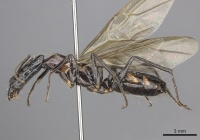Myrmostenus
| Myrmostenus | |
|---|---|

| |
| Scientific classification | |
| Kingdom: | Animalia |
| Phylum: | Arthropoda |
| Class: | Insecta |
| Order: | Hymenoptera |
| Family: | Formicidae |
| Subfamily: | Formicinae |
| Tribe: | Camponotini |
| Genus: | Camponotus |
| Subgenus: | Myrmostenus Emery, 1920 |
| Type species | |
| Camponotus mirabilis
| |
Narrow-head Carpenter Ants
Diagnosis. Emery (1925). - "Queen. - Large species; body narrow and very long. Head depressed, very much longer than broad, with lateral margins parallel and posterior head margin either truncate or concave, or with lateral head margins converging posteriorly. Clypeus less depressed than cheeks, carinate, produced anteriorly and scalloping more-or-less marked. Frontal carinae rather short, sinuate; antennal toruli placed about at midlength of carinae. Mandibles weakly curved and with long apical tooth (C. mirabilis, Emery), or very curved with subequal teeth. Mesosoma very long and narrow. Petiolar scale thick, subnodiform; gaster very long. Worker (and soldier?) and male unknown.
Geographical distribution of species. - Confined to Peru, Bolivia, and Brazil [Brazilian records from MacKay (1997)."
(Translated and edited by B. E. Boudinot, 19 February 2017.)
Myrmostenus is currently a subgenus of Camponotus.
- Camponotus convexiclypeus
- Camponotus leptocephalus
- Camponotus longipilis
- Camponotus mirabilis
- Camponotus postangulatus
- Camponotus sphenocephalus
Nomenclature
The following information is derived from Barry Bolton's Online Catalogue of the Ants of the World.
- MYRMOSTENUS [subgenus of Camponotus]
- Myrmostenus Emery, 1920b: 250 [as subgenus of Camponotus]. Type-species: Camponotus mirabilis, by original designation.
Identification
MacKay (1997) revised Myrmostenus and provided a key to all species:
Queens have greatly elongated heads with a CI ranging from 48-101. The pronotum is also long, together with the remainder of the mesosoma. The basal face of the propodeum is much shorter than the dorsal face. Most surfaces are smooth and shining. Erect hairs are usually sparse and decumbent pubescence is usually absent. The head has a few long, coarse hairs near the top of head and usually along the frontal carinae. The cheeks extend past the base of the mandibles, usually forming distinct lobes. The workers and males are unknown.
Description - Queen measurements (mm): HL 2.36-4.70, HW 1.44-2.52, SL 208- 3.76, EL 0.56- 0.98. Indices: SI 48-101, CI 40-67.
Mandible with 6 poorly defined teeth, except for apical and subapical; clypeus large and wide, often with well-defined median carina; clypeal border slightly concave in all species except Camponotus mirabilis; eyes large and extending past lateral edges of head; ocelli well developed; scape extending past posterior border of head (except in C. mirabilis ); vertex concave or convex; maxillary palps with 6 segments; labial palps with 4 segments; mesosoma somewhat elongated and flattened; pronotum especially elongate; propodeum with long basal face and very short posterior face; petiole small, petiolar node relatively sharp.
Hairs sparse and coarse (except for Camponotus leptocephalus, which has abundant erect hairs); decumbent pubescence essentially absent (except C. leptocephalus, which has sparse pubescence).
Sculpture fine, most surfaces smooth and polished, except head, which is punctate in most species.
Color medium brown.
Distribution - Peru , Bolivia and Brasil.
Discussion - These ants are considerably modified, possibly for living under bark or in tunnels in wood. It is difficult to determine the affinities with other subgenera in Camponotus, but the lobes associated with the cheeks, the enlarged clypeus and polished integument suggests that they may be related to Pseudocolobopsis. They are, however, much larger than any known Pseudocolobopsis females.
Species Complexes - This subgenus contains three species complexes, the leptocephalus complex, the longipilis complex and the mirabilis complex. The leptocephalus complex consists of a single species, C. leptocephalus. This complex can be characterized as having a relatively larger CI (61), and having most surfaces covered with short, bristly hairs. The sculpture is rougher than in other species in the subgenus, especially obvious on the mesosoma. The longipilis species complex consists of four species: C. convexiclypeus, C. longipilis, C. postangulatus and C. sphenocephalus. These species can be characterized by having intermediate values of CI (51-67), lacking bristly hairs and having smooth and polished sculpture on the mesosoma and gaster, with the head sculptured to varying degrees with punctures. Finally, the mirabilis complex consists of a single species, C. mirabilis. This complex is characterized by having a very long head (CI 40- 44), which is noticeably widened anteriorly, lacking short, bristly hairs and in being smooth and shining throughout, including the head.
I am not interested in defending the concept of subgenera as valid taxonomic groupings, but only as a groupings of convenience. In this instance, we can group three apparently related species complexes conveniently into a larger group, the subgenus Myrmostenus.
References
- Bolton, B. 2003. Synopsis and Classification of Formicidae. Mem. Am. Entomol. Inst. 71: 370pp (page 117, Myrmostenus as subgenus of Camponotus)
- Emery, C. 1920b. Le genre Camponotus Mayr. Nouvel essai de la subdivision en sous-genres. Rev. Zool. Afr. (Bruss.) 8: 229-260 (page 250, Myrmostenus as subgenus of Camponotus)
- Emery, C. 1925d. Hymenoptera. Fam. Formicidae. Subfam. Formicinae. Genera Insectorum 183: 1-302 (page 161, Myrmostenus as subgenus of Camponotus)
- Mackay, W. P. 1997A. A revision of the Neotropical ants of the genus Camponotus, subgenus Myrmostenus (Hymenoptera: Formicidae). Proceedings of the Entomological Society of Washington 99:194-203.
- Wheeler, W. M. 1922i. Ants of the American Museum Congo expedition. A contribution to the myrmecology of Africa. VII. Keys to the genera and subgenera of ants. Bull. Am. Mus. Nat. Hist. 45: 631-710 (page 709, Myrmostenus as subgenus of Camponotus)

